You might say this has been the summer of the loon for me, as I developed an interest in documenting the growth and development of a young Common Loon on a west-central Minnesota lake. At the western edge of the species’ range, where the northern forest meets the Great Plains, my friend Andy has been hosting me and a group of friends including Linda and Dwight during 2 previous loon photography cruises in July and August. With the others returning to homes in Hollywood and Portland, Andy and I have been planning a third photo session adjacent to his lake home on Little Pelican Lake. Now, the young loon should be fully feathered and possibly fledged.
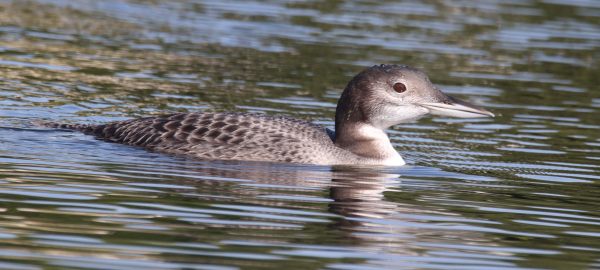
During the third visit to photograph the development of the young loon, its plumage was fully formed and ready for the fledgling to take its first flights (photo tech: 600mm zoom lens, f-8 aperture, 1/640 shutter speed, ISO 400).
During the first 2 pontoon cruises to find and photograph young loons, we had great luck and we were all quite enchanted with the birds during the extended periods we spent floating or following family groups. We started with 2 adult pairs, each with a downy hatchling about 3 weeks old, but during the second cruise 3 weeks later, we found out that 1 of the young loons didn’t make it, which made our interactions with the slightly younger loon all the more meaningful.
As I prepared for my 3-hour drive east on Thursday morning I had some fleeting concerns about whether the young loon would be on hand. Had I waited too long to return? Had the young loon fledged and left the area? Had it survived the past month of summer? In reality, Andy was pretty gung-ho to get our after-3pm pontoon trip started, which made me happy to see he was excited about what I considered a huge event. Certainly, I was more than satisfied with the photos we took the previous 2 photo sessions, but it would sure be nice to add a third update on the development of the young Common Loon.
Any apprehension about finding the loons vanished as Andy quickly sighted an adult within 2 minutes of leaving the dock, and with binoculars I quickly verified that the young loon was on hand too – Hooray! At first, the fledgling kept a very low profile close to the water, which was true during our previous visit too. But this time it seemed to continue this low positioning longer before the now fully feathered youngster fully accepted our presence, even from a distance. Conversely, the adult was trusting and seemingly unaffected by our appearance.
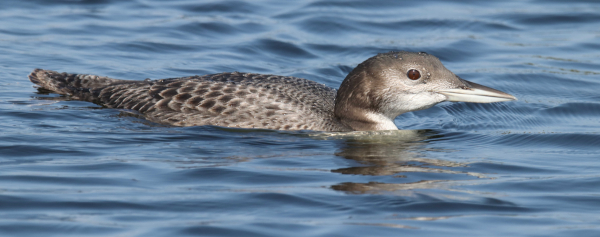
The beautiful tan hue on the plumage of the young loon shows a light-line that creates the “scalloped edge” on individual back feathers, which are indicative of first-year loons (420mm zoom, f-8 aperture, 1/800 shutter speed, ISO 400).
The young loon has been especially attractive in that its feathers have been colored more tan than gray; however, during our last look at the young loon it was only beginning to get its first feathers. I wondered if the now fully feathered fledgling would still show the tan-ish feather coloring. With the fledgling before us now, it was clear it indeed had tan-hued plumage, which was beautiful. We wondered if the young loon’s flight feathers were fully formed, and if it was starting to fly. Eventually, it raised up and flapped its wings, with the resulting photos showing all flight feathers appeared to be full-sized. (To simplify references to the young loon, I’m referring to it as a fledgling now.)
As for the adult, which I’m presuming was the female by size, shape, and demeanor, she was showing the indicators of her post-nesting molt into basic plumage. We could see winter white feathers on her face, dull black feathers on its head and nape replacing the iridescent alternate summer plumage, and many feathers were missing and being replaced on her back, flanks, and rump. Soon she will look like a completely different bird, plumage and color-wise.
The sunlight was perfect with shades of blue sky color reflected on the water. A light breeze rippled the water surface in spots, with a calm water surface in areas protected by the wind. With this background setting and the impressive loons providing a variety of photo opportunities, Andy was the usual slick pontoon captain, operating to balance being in photo range with not affecting the behavior or movements of the loons. In addition to the excitement of photographing, it was a beautiful afternoon to be on the lake surrounded by lush woodlands, with a hint of fall in the air and the first colors showing highlights on some leaves of a few trees.
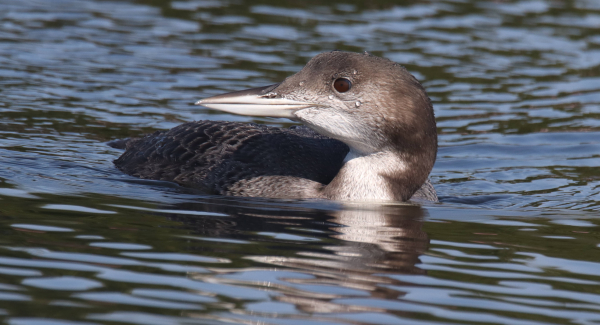
It was especially enjoyable when the loons surfaced near the pontoon, providing exceptional opportunities to take close portraits of the birds (600mm zoom, f-8 aperture, 1/1000 shutter speed, ISO 400).
The fledgling loon spent most of its time diving below the water surface, presumably “fishing.” According to the scientific species account for Common Loons in Birds of the World, the fledgling should now be catching more than 50 percent of its own food (mostly fish), becoming more self-sufficient and catching closer to 90 percent of its food soon. It should be swallowing some fish below water at this age, which Andy and I were wondering about as we watched the fledgling’s activities from the surface.
The loons were active in both deep and very shallow parts of the lake, and Andy was impressed with how long the loons stayed below the surface at a time and remarked about how we never knew where to expect the diving loons to surface – sometimes distant, sometimes just off the side of the boat. We spent about an hour within photo range of the loons, so had some good observation time, and the most enjoyable periods were when one or both loons approached the boat, sometimes swimming or surfacing within 10 feet.
At first, the fledgling kept a low profile in the water, holding its neck and head a fraction of an inch above the surface and keep its body flattened low, but after a few minutes it acted more relaxed and swam in upright positions. The adult always seemed at ease with the pontoon floating an appropriate distance away, which is the distance where the loons seem unaffected by our presence. Andy was in tune with the loons, keeping his distance and reacting to their movements in relation to the direction of the sunlight.
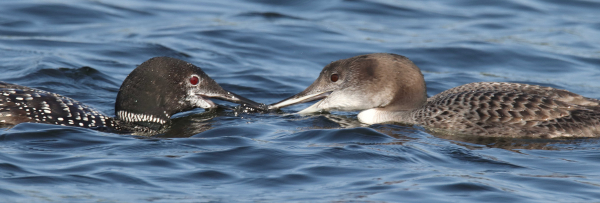
During the first half of the photo session, the young loon did almost all of the dives, presumably to catch fish; but after repeatedly begging the adult for food, the female fished in earnest along with the fledgling, passing small fish to the young loon as documented here (500mm zoom, f-8 aperture, 1/800 shutter speed, ISO 400).
If it isn’t already happening, the fledgling should begin exercising its wings more and practicing take-offs and flights at this age, although the Birds of the World account notes flight practice activities are most common during breezy cooler weather, most often during morning hours. Andy and I thought we might check back on the loon’s progress, as well as the progress of the adult’s molt into basic plumage in 2 or 3 weeks, which would also coincide with prime fall foliage in the surrounding variety of trees, including maple, oak, ash, and poplar trees. What can we expect during coming weeks? According to Birds of the World, in some areas fledgling loons become independent during mid-September – probably in northern Canada – while some fledglings the United States may not become independent until October or even early November.
One adult of the pair may leave the territory about 10 weeks after the young hatch, which is what may have already happened with this pair. The remaining adult will stay with the fledgling at least 12 weeks, but likely longer. When on its own, the fledgling will stay on the natal lake 1 to 3 weeks, then fly to a nearby larger lake to interact with other recent fledglings before beginning fall migration. Most loons nesting in Minnesota and young of the year probably migrate south during October.
Loon Photo Tech
On the camera tech side of this loon photography session, the light and activity levels were such that I kept my camera’s settings at the most basic aperture, f-8, which provided more than adequate shutter speeds at an ISO 400, which is my usual setting in bright sunlight. I use the Av Mode setting, which allows me to dictate the aperture (f-stop) and the camera automatically provides the compensating shutter speed. Any time I photograph in optimum lighting conditions, I have my camera pre-set at those levels, then adjust as needed when photographing in the moment. In this case, there was no need to make any changes, and the resulting photos were perfectly exposed, sharp, and clear.
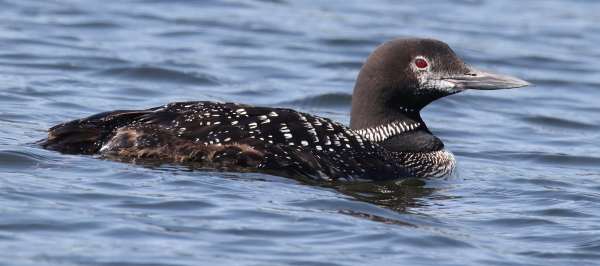
Showing the advance of the adult’s post-nesting molt into basic plumage, winter white feathers are most evident on her face, while dull black feathers on its head and nape are replacing the iridescent alternate summer plumage, and many feathers were missing and being replaced on her back, flanks, and rump (600mm zoom, f-8 aperture, 1/500 shutter speed, ISO 400).
I was using my Tamron 150-600mm zoom lens, usually at the maximum 600mm zoom setting, but zooming out to a wider view when the loons were closer. This lens has built-in vibration compensation to help stabilize the lens, which allows users to effectively hand-hold the lens at high magnifications without the need for a cumbersome tripod. To facilitate reducing motion or vibrations, Andy turned the pontoon engine off when we were in position to photograph, and I braced the lens with my elbows held against my body and held my breath when pressing the shutter button. While photographing, I habitually lightly touch the shutter button to ensure the lens’ auto-focus is always focused optimally.
In advance of our loon photo session, I watched the weather reports for predicted sunlight conditions as much as 10 days in advance of the mid-week days when I could break away from home and office. Andy and I originally planned for a pre-Labor Day outing, and initial weather reports suggested a perfect day for August 31st. However, as the days ticked closer the weather predictions deteriorated, and in the end, Andy had a business emergency he needed to attend to. We opted for the following Thursday, September 7, which turned out to be a pretty perfect afternoon on the water with the loons.
With the timing related to weather and availability of sunlight looking good, the time of day was the other important consideration. We have had good luck photographing on the water between 4pm and 6pm, so with a 3pm start I was a little anxious the light might be overly bright for a while. But with changes in the length of daylight and an earlier sunset now, it turned out that with a cloudless sky and full sunlight the timing was right. The shades of blue sky color reflected on the water with varied rippling yielding to nearly calm water made the photos the best they could be, and at times the loons swam through reflections of green tree leaves and yellow cattails, which added some different color perspectives and a bit of artistry in the resulting images.
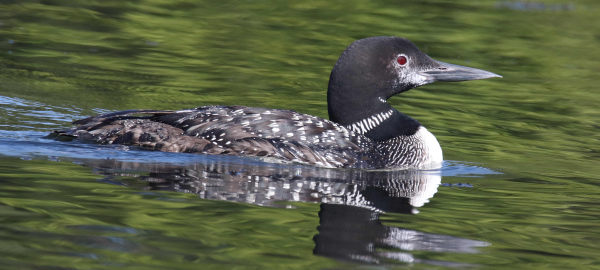
As the loons swam through reflections of green tree leaves or yellow cattails, the colors reflected on the water provided an artistry in the resulting photos, even suggesting brush strokes in some images (photo tech: 600mm zoom plus enlarged by cropping, f-8 aperture, 1/500 shutter speed, ISO 400).
Follow Through
This is a prime example of how birding isn’t necessarily a one-time effort, with some birding opportunities there can be multiple, even long-range photo planning through a given period, especially during the nesting and post-nesting season. While this could be the finale to our loon photo trips, with an exciting assortment of photographs to illustrate the development of the young loon, Andy and I are still considering one more loon photo session in a couple weeks, when autumn colors in the Northwoods of Minnesota are at their best, and when I might be able to document another phase of the adult’s molt.
The fledgling loon may not change much in looks, but its behavior may change as it masters flight, perhaps exercising its wings with more wing flaps, and making regular takeoffs and flights. I’ll check in with Andy about fall colors, and we’ll make a plan when the woods are veiled in yellow, orange, gold, red, brown, and varied shades of green leaves with a warm autumn afternoon reflecting sky blue water color on a tranquil lake. Can’t wait!
Article and photographs by Paul Konrad
Share your bird photos and birding experiences at editorstbw2@gmail.com